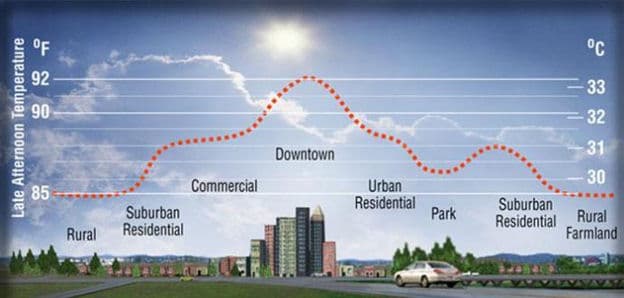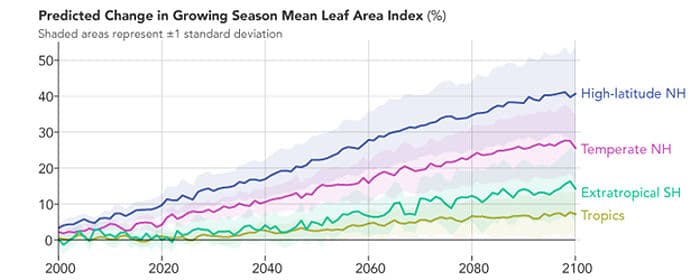Much technical and artistic effort has been expended to provide the public with some perspective on what life would be like in a warmer world at the turn of the next century. Much of what has been presented is grossly exaggerated. However, it does not take much real effort to see and feel what life would be like in a world approximately 7°F warmer than today. All that is necessary is a trip from a rural area to the nearest major city, which is already approximately 7°F warmer in the late afternoon heat than the rural areas surrounding it. (link)

The earth is approximately 30% land and 70% water, primarily oceans. Approximately 3-4% of earth’s land area is described as urban. These urban areas constitute urban heat islands which are warmer, both day and night, than the rural and exurban areas surrounding them. These heat islands are the result of wind blocking, local energy consumption and rejection and decreased albedo caused by roads, sidewalks and building roofs. Nighttime temperatures are warmer as the result of the release of heat stored in the urban infrastructure during the heat of the day.
Studies in the US have determined that a large percentage of the temperature measuring stations in the US have been affected by these urban heat islands, suggesting that calculated near-surface temperature anomalies are higher because of the influence of nearby urban heat islands. Similar studies in other nations would likely produce similar results.
Interestingly, numerous groups and some government officials are working to limit what is referred to as urban sprawl into suburban, exurban and rural areas surrounding the downtown and urban residential areas in the cities. This would further concentrate population in the urban cores, likely increasing the urban heat island effect in the cities.
Several different approaches have been suggested to reducing the magnitude of the UHI effect in cities, including white or silver painted roofs, rooftop plantings, increased green space around buildings, development of urban parkland and restriction or elimination of private motor vehicle traffic in the urban core. None of these approaches have been demonstrated on a scale sufficient to significantly offset the primary contributors to the UHI effect.
The global greening measured by satellite observations has had little effect on urban heat islands because there are relatively few green plants available in those environments to take advantage of the positive effects of increase atmospheric CO2. The greening has, however, been sufficient to measurably decrease desert areas including the Sahara. The greening is expected to continue through the remainder of this century at a relatively constant pace, as shown in the graph below.

Despite existing and projected future warming, net voluntary migration continues to be predominantly from colder to warmer climates, though that might change if the warming projected by the climate models were to actually occur. However, that voluntary migration to warmer climates does not include voluntary migration to urban heat islands from the suburban, exurban and rural areas surrounding them for multiple reasons.


